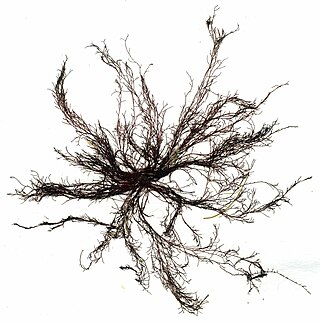
The Chlorophyceae are one of the classes of green algae, distinguished mainly on the basis of ultrastructural morphology. They are usually green due to the dominance of pigments chlorophyll a and chlorophyll b. The chloroplast may be discoid, plate-like, reticulate, cup-shaped, spiral- or ribbon-shaped in different species. Most of the members have one or more storage bodies called pyrenoids located in the chloroplast. Pyrenoids contain protein besides starch. Some green algae may store food in the form of oil droplets. They usually have a cell wall made up of an inner layer of cellulose and outer layer of pectose.

The Zygnematales, also called the Conjugatales, are an order of green algae, comprising several thousand different species in two families. The larger family Zygnemataceae, with well-known genera such as Zygnema and Spirogyra, includes members that grow as unbranched filaments, which grow longer through normal cell division. This group includes the desmids. Most members of both families live in freshwater, and form an important component of the algal scum that grows on or near plants, rocks, and various debris.

The Zygnemataceae are a family of filamentous or unicellular, uniseriate (unbranched) green algae. The filaments are septated and reproduction is by conjugation; Spirogyra is commonly used in schools to demonstrate this kind of reproduction. The family is notable for its diversely shaped chloroplasts, such as stellate in Zygnema, helical in Spirogyra, and flat in Mougeotia. The Zygnemataceae are cosmopolitan, but though all generally occur in the same types of habitats, Mougeotia, Spirogyra, and Zygnema are by far the most common; in one study across North America, 95% of the Zygnemataceae collected were in these three genera. Classification and identification is primarily by the morphology of the conjugation, which is somewhat rare to find in natural populations of permanent water bodies; when in the vegetative state, the rarer genera resemble the three most common, and are often mistaken for them and catalogued as such. Conjugation can be induced in low-nitrogen culture. While they occupy many habitats, in North America all are found solely in freshwater or subaerial habitats. Species typically exist as floating mats in stagnant water in ditches and ponds, but some also grow in moving water, attaching themselves to a substrate by rhizoid-like projections of the basal cells of the filament. The mat species rise to the surface in early spring, grow rapidly through the summer, disappearing by late summer. Members of the Zygnemataceae, such as Spirogyra, fall prey to parasites, especially chytrids. Most genera previously assigned to Mesotaeniaceae as well as the Desmidiales actually emerged in the Zygnematacae.

Palmaria palmata, also called dulse, dillisk or dilsk, red dulse, sea lettuce flakes, or creathnach, is a red alga (Rhodophyta) previously referred to as Rhodymenia palmata. It grows on the northern coasts of the Atlantic and Pacific Oceans. It is a well-known snack food. In Iceland, where it is known as söl[ˈsœːl̥], it has been an important source of dietary fiber throughout the centuries.

Ulothrix is a genus of green algae in the family Ulotrichaceae.

Halimeda is a genus of green macroalgae. The algal body (thallus) is composed of calcified green segments. Calcium carbonate is deposited in its tissues, making it inedible to most herbivores. However one species, Halimeda tuna, was described as pleasant to eat with oil, vinegar, and salt.
Schmitzia hiscockiana is a small, rare, red seaweed or marine alga of the phylum Rhodophyta or red algae. It was discovered and named in 1985.

Polysiphonia is a genus of filamentous red algae with about 19 species on the coasts of the British Isles and about 200 species worldwide, including Crete in Greece, Antarctica and Greenland. Its members are known by a number of common names. It is in the order Ceramiales and family Rhodomelaceae.

Dictyosphaeriaceae is a family of green algae. As of February 2022, AlgaeBase places two genera in the family:

Botryococcus is a genus of green algae. The cells form an irregularly shaped aggregate. Thin filaments connect the cells. The cell body is ovoid, 6 to 10 μm long, and 3 to 6 μm wide. Fossils of the genus are known since Precambrian times, and form the single largest biological contributor to crude oil, and are a major component of oil shales.

Trentepohlia is a genus of filamentous chlorophyte green algae in the family Trentepohliaceae, living free on terrestrial supports such as tree trunks and wet rocks or symbiotically in lichens. The filaments of Trentepohlia have a strong orange colour caused by the presence of large quantities of carotenoid pigments which mask the green of the chlorophyll.

Zygnematophyceae is a class of green algae in the paraphylum streptophyte algae, also referred to as Charophyta, consisting of more than 4000 described species. It contains five orders: the Spirogloeales, the Serritaeniales, the Zygnematales, the Spirogyrales, and the Desmidiales. The Zygnematophyceae are the sister clade of the land plants. The body plan of Zygnematophyceae is simple, and appear to have gone through a secondary loss of morphological complexity. The most basal members are unicellular, but filamentous species have evolved at least five times. They contain genes involved in protection from desiccation that appear to have been derived by horizontal gene transfer from bacteria; the genes are found in plants, Zygnematophyceae, bacteria, but no other organisms. The genes may have helped to enable plants to make the transition to life on land.

Claudea is a marine red alga genus.

Chaetomorpha linum is a species of green algae in the family Cladophoraceae.
Mastophora is a genus of thalloid alga comprising four species. The dimerous, crustose thalli comprise two groups of filaments. The bulk of the thallus is made of erect filaments, which may be one or many cells long. These grow approximately perpendicular to the filaments of a basal layer, usually one cell thick. haustoria, haustoria, and palisade cellsare present in the organisms but lack secondary pit connections. Mastophora reproduces by means of conceptacles; it produces tetraspores and dispores.














